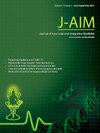从用于治疗COVID-19患者的阿育吠陀配方中识别治疗重要化学物质的药物信息学
IF 1.9
Q3 INTEGRATIVE & COMPLEMENTARY MEDICINE
引用次数: 0
摘要
在2019冠状病毒病大流行期间,优育吠陀提供了许多创新解决方案。探索有效的阿育吠陀配方中的植物化学成分是很重要的。目的从某阿育吠陀医院治疗COVID-19患者的5种阿育吠陀配方中鉴定活性植物成分。材料与方法本研究采用药物信息学技术。利用GLIDE软件对967个化合物与SARS-CoV-2相关的8个不同大分子病毒靶点进行化学信息学、三维分子结构构建和分子对接。并进行了分子动力学模拟。采用SwissADME web服务器测定其理化、亲脂性及吸收、分布、代谢和排泄(ADME)参数。结果分子对接结果表明,槲皮素-3- o -阿拉伯葡萄糖苷、槲皮素-3,7- o -二葡萄糖苷、甘草酸、钙根苷B、乳酸-2-没食子酸酯、原薯蓣皂苷和独立苷D是与8种SARS-CoV-2病毒蛋白有效结合的植物化学物质,可作为开发抑制SARS-CoV-2多靶点药物的先导化合物。MD模拟有助于从对接分析中选择的7条引线中确定5条。结论5种阿育吠陀制剂可用于治疗COVID-19相关呼吸系统疾病。通过采用药物信息学技术,确定了这些制剂中存在的五种植物成分为先导。本文章由计算机程序翻译,如有差异,请以英文原文为准。
Pharmacoinformatics in identifying therapeutically important chemical species from Ayurvedic formulations employed in treating COVID-19 patients
Background
Ayurveda provided many innovative solutions during the COVID-19 pandemic. It is important to explore the phytochemical constituents in effective Ayurvedic formulations.
Objective
The main aim of the work is to identify active phytoconstituents from five Ayurvedic formulations employed in treating COVID-19 patients in an Ayurvedic hospital.
Material and methods
Pharmacoinformatics technologies were employed in this study. The chemoinformatics, 3D molecular structure building, and molecular docking of 967 compounds on eight different macromolecular viral targets associated with SARS-CoV-2 were carried out using GLIDE software. Molecular dynamics simulations were also performed. SwissADME web server was employed to determine the physicochemical, lipophilicity and absorption, distribution, metabolism, and excretion (ADME) parameters.
Results
The molecular docking results indicate that quercetin-3-O-arabinoglucoside, quercetin-3,7-O-diglucoside, glycyrrhizin, calceolarioside B, mucic acid-2-gallate, protodioscin and indioside D are the phytochemicals which effectively bind to eight of the proteins of SARS-CoV-2 virus and these may be treated as new lead compounds for multi-target drug discovery for SARS-CoV-2 inhibition. MD simulations helped in identifying five leads out of seven chosen from docking analysis.
Conclusion
Five Ayurvedic formulations were used to treat respiratory illnesses associated with COVID-19. Five phytoconstituents present in these formulations were identified as leads by employing pharmacoinformatics techniques.
求助全文
通过发布文献求助,成功后即可免费获取论文全文。
去求助
来源期刊

Journal of Ayurveda and Integrative Medicine
INTEGRATIVE & COMPLEMENTARY MEDICINE-
CiteScore
4.70
自引率
12.50%
发文量
136
审稿时长
30 weeks
 求助内容:
求助内容: 应助结果提醒方式:
应助结果提醒方式:


